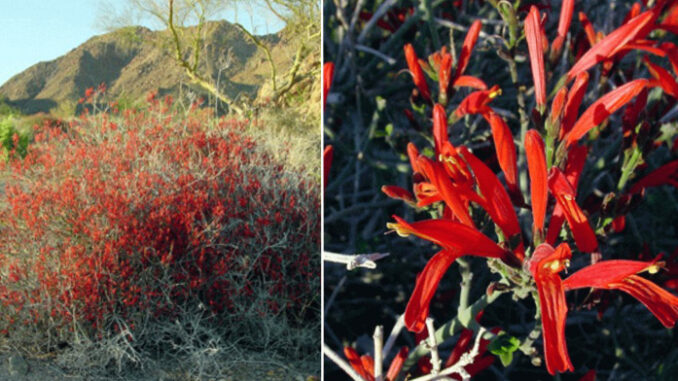
Chuparosa, Justicia californica, (aka Beloperone) is a perennial plant native to Southeastern California and the Sonoran Desert including Arizona, and Sonora and Baja California, Mexico. It is a favorite of hummingbirds which go after the nectar. Other birds go after the sugar-rich center of the flower and seeds. The fruit are elongated, club-shaped capsules about one-half inch long which contain four seeds in the inflated tip.
Chuparosa is a shrub that can grow three- to five feet high and six- to eight feet wide. It is usually found in dry washes and on rocky slopes below elevations of 2,500 feet. The shrub is usually grayish green with hairy branches. Plants initially have succulent oval leaves, up to one inch long, that give way to bright red (and sometimes orange or yellow) flowers. The flowers, up to two inches long, are tubular and grow in clusters at the end of stems. The flowers have a large “lower lip” that opens to reveal a white anther which contains the pollen. According to the Arizona-Sonora Desert Museum (ASDM), Chuparosa flowers can be found any month of the year, except during drought or right after freezes. Big blooms often occur in the winter and early spring months.
According to DesertUSA, “This member of the large, tropical Acanthus family (Acanthaceae) is the only New World genus that extends north into the US. The common name chuparosa, “sucking rose” in Spanish, is abundant with nectar, making it popular among various birds, especially hummingbirds. Quail and house finches eat the seeds. Known locally as honeysuckle, chuparosa is said to have been eaten by the Papago Indians.” Chuparosa is browsed by livestock and deer.

Chuparosas are very drought tolerant and often cultivated as a landscape ornamental in desert regions for its bright flowers and to attract birds. ASDM has a plant care guide for chuparosa here and notes that they can survive quick dips in temperature to 22°F.
See more photos here.
Note to readers:
Visit my blog at: https://wryheat.wordpress.com/
Index with links to all my ADI articles: http://wp.me/P3SUNp-1pi
My comprehensive 30-page essay on climate change: http://wp.me/P3SUNp-1bq
A shorter ADI version is at https://arizonadailyindependent.com/2013/08/01/climate-change-in-perspective/
[metaslider id=65385]
